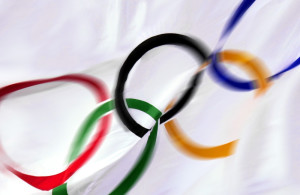 Image #1 Waving Glory, the Olympic Rings … 1984 Summer Olympic Games, Los Angeles, CA. My sports photography career began in 1980. I have had the great privilege of covering 12 Olympic Games, (6 summer and 6 winter) as a photojournalist. As a hired freelance photographer my first two Olympics, 1984 Los Angeles and 1988 Calgary were for The United States Olympic Committee, while the remaining 10 were for Newsweek Magazine. Image #1 Waving Glory, the Olympic Rings … 1984 Summer Olympic Games, Los Angeles, CA. My sports photography career began in 1980. I have had the great privilege of covering 12 Olympic Games, (6 summer and 6 winter) as a photojournalist. As a hired freelance photographer my first two Olympics, 1984 Los Angeles and 1988 Calgary were for The United States Olympic Committee, while the remaining 10 were for Newsweek Magazine.
I photographed many of the National and International competitions, the World Championships and World Cup events, along with the Olympic Trials in a wide variety of Olympic sports. The corner stone of my freelance photography business was covering all the significant Pre Olympic competitions that lead up to and of course included the Olympic Games themselves.
Filling the picture archives of the US Olympic Committee and the pages of an internationally renown magazine like Newsweek involved more than just capturing an image of an Olympian receiving their Gold medal. I probably have well over 1,000 images of “Olympic Ambiance.” The Olympic Rings represent the five continents brought together by the Olympic Movement, or the five main regions: Africa, the Americas (North and South combined), Asia, Europe, and Oceania, as stated in the Olympic Charter. The Olympic Rings are everything Olympic and everywhere within the Olympic Movement. The Olympic Rings are on stadiums, playing fields, uniforms, equipment, banners, formed in flowers and in firework displays, they are tattooed on athletes, carved into ice, and are of course fly in the wind as a flag. This is one of my favorite Olympic Flag images. Nikon F3 Camera, Kodak Ektachrome Film, ASA100, 1/60 at f16, Nikon 600mm f4.0 lens with 2X Teleconverter, Gitzo Monopod.
|
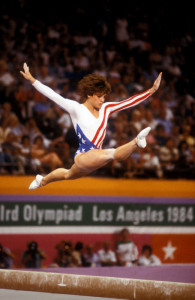 Image #2 Golden Girl, Mary Lou Retton … 1984 Summer Olympic Games, Los Angeles, CA. I usually show my often published images of Mary Lou Retton scoring the perfect 10.0 on Vaulting and then receiving her Gold Medal for winning the Women’s Gymnastics All Around competition. But this image of her flying high above the Balance Beam has always been a personal favorite for me. Balance Beam was Mary Lou’s “weak event” as it would be called in the sport of gymnastics. For her to win the All Around event meant she must perform brilliantly on all 4 women’s events: Floor Exercise, Uneven Parallel Bars, Vaulting, and the Balance Beam. While she did score a perfect 10.0 on Vaulting to seal the deal and win the All Around Gold, she first had to score well on the Beam, which she did. After following her career sense 1981, I was very familiar with all of Mary Lou’s routines by her Olympic debut. I knew precisely were she would perform her “switch leap” on the beam. And so I positioned myself so that she would leap over the words Olympiad Los Angeles 1984 that are visible in the background. I made only one frame to capture this image of Mary Lou in complete split and maximum height. I had gotten to know Mary Lou quite well during those years. She is as bubbly in person as she was on TV during the Games. I gave her prints of all the best images I had from the 1984 Olympic Games to which she also chose this picture as one of her favorites. Nikon F3 Camera, ASA (ISO) 640 Kodak Tungsten Film, 1/500 at f2.0, Nikon 135mm f2.0 lens. Image #2 Golden Girl, Mary Lou Retton … 1984 Summer Olympic Games, Los Angeles, CA. I usually show my often published images of Mary Lou Retton scoring the perfect 10.0 on Vaulting and then receiving her Gold Medal for winning the Women’s Gymnastics All Around competition. But this image of her flying high above the Balance Beam has always been a personal favorite for me. Balance Beam was Mary Lou’s “weak event” as it would be called in the sport of gymnastics. For her to win the All Around event meant she must perform brilliantly on all 4 women’s events: Floor Exercise, Uneven Parallel Bars, Vaulting, and the Balance Beam. While she did score a perfect 10.0 on Vaulting to seal the deal and win the All Around Gold, she first had to score well on the Beam, which she did. After following her career sense 1981, I was very familiar with all of Mary Lou’s routines by her Olympic debut. I knew precisely were she would perform her “switch leap” on the beam. And so I positioned myself so that she would leap over the words Olympiad Los Angeles 1984 that are visible in the background. I made only one frame to capture this image of Mary Lou in complete split and maximum height. I had gotten to know Mary Lou quite well during those years. She is as bubbly in person as she was on TV during the Games. I gave her prints of all the best images I had from the 1984 Olympic Games to which she also chose this picture as one of her favorites. Nikon F3 Camera, ASA (ISO) 640 Kodak Tungsten Film, 1/500 at f2.0, Nikon 135mm f2.0 lens. |
 Image #3 Golden Girls, Evelyn Ashford and Florence Griffith Joyner (Flo Jo) … 1988 Summer Olympics, Seoul, South Korea. By the time the 1988 Seoul, South Korea Olympics came around I was a seasoned freelance sports photographer. Florence Griffith Joyner, a.k.a. “Flo Jo” was all the sporting news and the outright favorite to win the Gold in the women’s 100 meters. I photographed several international Track and Field competitions prior to the 1988 Games, and was covering the Olympic Trials for the US Olympic Committee when Flo Jo unveiled her white lace sprinting suit. I covered 5 days of Track and Field during the Games in Seoul and made many good pictures, but my favorite was made during the women’s 4x100mm relay final. In 1988 the US was notorious for having poor baton hand-offs in relay events. Such was the case between Flo Jo running the 3rd leg and handing off to Ashford to finish the 4th leg remaining 100 meters. I usually try and get to an event early, but I was delayed arriving at the Olympic stadium because of Boxing semi finals running longer than expected. I felt like I was sprinting for a medal as I made my way to the turn 4 photo well. Image #3 Golden Girls, Evelyn Ashford and Florence Griffith Joyner (Flo Jo) … 1988 Summer Olympics, Seoul, South Korea. By the time the 1988 Seoul, South Korea Olympics came around I was a seasoned freelance sports photographer. Florence Griffith Joyner, a.k.a. “Flo Jo” was all the sporting news and the outright favorite to win the Gold in the women’s 100 meters. I photographed several international Track and Field competitions prior to the 1988 Games, and was covering the Olympic Trials for the US Olympic Committee when Flo Jo unveiled her white lace sprinting suit. I covered 5 days of Track and Field during the Games in Seoul and made many good pictures, but my favorite was made during the women’s 4x100mm relay final. In 1988 the US was notorious for having poor baton hand-offs in relay events. Such was the case between Flo Jo running the 3rd leg and handing off to Ashford to finish the 4th leg remaining 100 meters. I usually try and get to an event early, but I was delayed arriving at the Olympic stadium because of Boxing semi finals running longer than expected. I felt like I was sprinting for a medal as I made my way to the turn 4 photo well.
I no sooner found an open photo position trackside when I heard the gun sound the start of the 4×100 race. I hoisted my Nikon 400mm f2.8 and hand held it, as there was no time to mount the lens to my Gitzo monopod. The crowd roar was deafening as I scrambled to load a roll of daylight film into my Nikon F4 camera. The athletes were in the backstretch as I called upon my experience to tell me that ISO100, 1/1000 and an aperture setting of f4.5 (remember, no digital yet, just manual settings on both camera and lens) would be the correct exposure. As the athletes entered turn #3 I manually follow focused on Flo Jo as she motored into the exchange zone and I made 3 frames of the baton exchange. I could see that Ashford had slightly miss calculated her teammate’s advancing speed into the zone and Flo Jo had to pull up in order to make the exchange into Ashford’s left hand. Ashford sped away and 10 seconds the race was over…and the US had won the Gold. My filming of the moment did not even take 2 seconds. This single image shows not only the nearly missed hand-off, but also the look of concern for the situation on Ashford‘s face.
The sound of the start gun, the crowds roar as they sprinted around the 400 meter track, and the urgency and excitement of the approaching Olympic moment in time all comes back to me when I look at this picture. Nikon F4 camera, Kodak Film ASA (ISO) 100, 1/1000 at between f4 and f5.6, Nikon 400mm f2.8 lens.
|
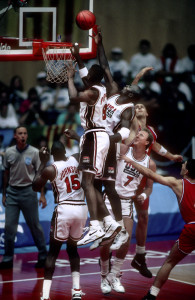
Image #4 Dream Team: Jordan, Pippin, Johnson, and Bird… 1992 Summer Olympics, Barcelona, Spain. After turning in my 25 rolls of film from the Jennifer Capriati Tennis Final to be processed at the Kodak Olympic Film Center, I then walked into the Newsweek office on the 4th floor of the MPC (Main Press Center) where Newsweek photo editor Hillary Raskin greeted me. Hillary (who looked like the twin sister of Shelly Long from Cheers) informed me that I needed to pack up my gear and hurry over to the Synchronized Swimming Finals for the evening deadline. I said, “I’m on my way…” At that moment Frank Deford, Newsweek’s own world renown writer, stood up at his desk and said…”Synchronized Swimming?” “The Dream Team is playing for the Gold tonight. Pack up your gear for basketball and cover that instead.” I looked at Deford, then at Hillary (she nodded) and then back to Deford and said, WOW, Thanks Frank!
I arrived about 30 minutes or so before tip off and spoke to Newsweek photographer John McDermott who had acquired a prime photo position under the basket. We agreed that I should be at the other end of the court so that we would not miss any key moments of the action. All under the basket photo positions opposite John were triple packed as were all other baseline and court level photo areas, so I went upstairs to the only open photo position left, … but I was there to photograph the biggest story of the Games, the Dream Team! The arena lighting was adequate for TV but poor for even the best high ASA film of the day. I seized the opportunity to use my Nikon 300mm f2.0 lens…you heard me right, Nikon used to make a 300mm f2.0 lens…and it was a monster. The fast f2.0 aperture would allow me to achieve 1/500 shutter speed and use Kodak’s new Kodachrome ASA500 film. I made many good pictures from my location, but I would admit that no key moment stood out in my mind. Then, with only 2 minutes left in the crushing of Croatia, Larry Bird finally came into the game. He had been sidelined with a back injury for most of the Olympics, and had not seen any action in the Gold Medal game. Next play, up goes Michael Jordan, with Scotty Pippin, Magic Johnson and Larry Bird all clustered with him at the opposite end of the court. I shot 2 frames at the peak of Jordan’s jump. This one showed the ball just leaving his fingertips and Bird visible in the scene. Nikon F4 Camera, Kodak Kodachrome ASA (ISO) 500 film pushed processed to ASA (ISO) 800, 1/500 at f2.0, Nikon 300mm f2.0 lens, Gitzo Monopod.
|
 Image #5 The Magnificent 7: USA Women’s Gymnastics Team Gold … 1996 Summer Olympics, Atlanta, GA. My ties to the sport of Gymnastics goes way back to my childhood. I began in the sport at age 8, competed in age group competitions up to High School and then helped my High School team to win 2 consecutive State Titles. Then I competed at the NCAA level where we won the 1972 NCAA division 1 Men’s Gymnastics Team title. I even coached for a few years at both the University level and Jr. Olympic level… then I began my photography career shooting, you guessed it, Gymnastics. I was again covering this Olympics for Newsweek Magazine, and was a “one-man-wrecking-crew” of efficiency while covering the sport of gymnastics according to Jimmy Coltan, Newsweek’s photo editor for the 1996 Olympic Games. Image #5 The Magnificent 7: USA Women’s Gymnastics Team Gold … 1996 Summer Olympics, Atlanta, GA. My ties to the sport of Gymnastics goes way back to my childhood. I began in the sport at age 8, competed in age group competitions up to High School and then helped my High School team to win 2 consecutive State Titles. Then I competed at the NCAA level where we won the 1972 NCAA division 1 Men’s Gymnastics Team title. I even coached for a few years at both the University level and Jr. Olympic level… then I began my photography career shooting, you guessed it, Gymnastics. I was again covering this Olympics for Newsweek Magazine, and was a “one-man-wrecking-crew” of efficiency while covering the sport of gymnastics according to Jimmy Coltan, Newsweek’s photo editor for the 1996 Olympic Games.
I shot plenty of action of each competitor that might contribute to the women’s team victory. Russia and Romania were in heated battle for the Gold with the US. When Keri Strug injured herself on the Vault, I was all over that key moment, and when Bela Karolyi carried her out to the podium to receive her gold medal I shot an entire roll of film. But it is this picture that I really treasure the most because I knew each young lady on the team so well. I had been photographing all of them sense the beginning of their careers. Left to right: Amanda Borden, Dominique Dawes, Amy Chow, Jayce Phelps, Dominique Moceanu, Kerri Strug, and Shannon Miller began as junior gymnasts with amazing promise years earlier. I first photographed them when they were just 9 and 10 years old, and on this day photographed them as they achieved their goal of winning the Gold medal. I cried when they got their medals. I could hardly hold the camera and 300mm f2.0 lens still. I still keep in touch with these young ladies. The London Games will feature the 2012 USA Women’s Olympic Gymnastics Team, a.k.a. “The Fab 5” as they contend for the Gold, but the ladies in this picture will always be the Magnificent 7, as was the title the media dubbed them in 1996. Nikon F5 Camera, Kodak Kodachrome ASA (ISO) 500 film pushed processed to ASA800, 1/250 at f2.8, Nikon 300mm f2.0 lens, Gitzo Monopod.
|
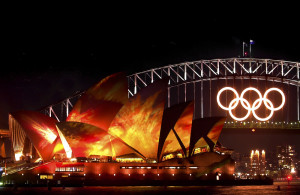 Image #6 Olympics Down Under, Opera House and Olympic Rings … 2000 Summer Olympics, Sydney, Australia. This image of the Sydney Opera House and Olympic Rings illuminated on the Sydney Bridge is a memory comprised of 2 separate golden memories for me. First of all, the 2000 Summer Olympics in Sydney, Australia marked a huge change in my career and in the photography industry. It was this Olympic Games that I would shoot digital using Nikon’s first edition D1 digital SLR camera. At Newsweek’s pre-Olympic meeting 5 days prior to Opening Ceremonies, Newsweek’s Photo Editor Kelly Grant asked the photo staff if anyone was familiar shooting digital. I was the only photographer to raise my hand. “Done deal…Dave, you will shoot digital the entire games.” Image #6 Olympics Down Under, Opera House and Olympic Rings … 2000 Summer Olympics, Sydney, Australia. This image of the Sydney Opera House and Olympic Rings illuminated on the Sydney Bridge is a memory comprised of 2 separate golden memories for me. First of all, the 2000 Summer Olympics in Sydney, Australia marked a huge change in my career and in the photography industry. It was this Olympic Games that I would shoot digital using Nikon’s first edition D1 digital SLR camera. At Newsweek’s pre-Olympic meeting 5 days prior to Opening Ceremonies, Newsweek’s Photo Editor Kelly Grant asked the photo staff if anyone was familiar shooting digital. I was the only photographer to raise my hand. “Done deal…Dave, you will shoot digital the entire games.”
I was amped up with the idea because I had been shooting the Nikon D1 in place of film throughout 1999. I was greatly impressed with the High ISO range of the D1 v.s. any of the High ASA Films on the market, and I had shot all the pre Olympic events leading into the Games with the D1. What I didn’t know was that Newsweek photo editors were only in their beginning stages of understanding digital workflow. I would not only be covering the games, but also assisting the editors in how to prepare my images for both publication and the Newsweek website, which was just debuting.
The second memory this image brings to my mind is how the making of the image unfolded. Not all Olympic photographers get to cover the Opening Ceremonies. Rather, each magazine publication, picture agency, and wire service is awarded 1-2 Opening Ceremonies credentials. In effect, it is a ticket for a specific photo position. Photo editors’ make the tough decision of selecting 1 or 2 of their photographers to cover the Opening Ceremonies. I had already covered all the previous Olympic Opening Ceremonies since 1984, so when Kelly appointed me to cover the Sydney Opening Ceremonies, I declined. I suggested that the opportunity be passed on to one of the other photographers who had never seen an Opening Ceremony. I then suggested that I go to the Sydney Harbor to photograph the illumination of the Opera House and Olympic Rings that was scheduled to occur during the same time as the Opening Ceremonies. Another done deal.
I arrived on the small peninsula across from the Sydney Opera House and Sydney Bridge about 2 hours before the start of the Opening Ceremonies. I was not alone. There must have been 250 other photographers who had the same assignment from their photo editor. I set up 3 Nikon D1 cameras with a variety of lens choices, mounted them on tripods, composed the scene, focused on the Opera House and waited for “The Moment” when the Opera House and Olympic Rings would be illuminated. I had acquired a written timeline of the Opening Ceremonies broadcast script, and so I knew when various key moments of the production would occur. We were told that the Opera House and Rings would be illuminated at the start of the Ceremonies. The Ceremonies began andddddd…no illumination of the Opera House or the Olympic Rings. OK, maybe when the athletes march in…nothing. OK, Maybe when the Olympic Flame is lit…nope, no illumination. By now many of the 250 photographers began to pack up their gear and leave, thinking “The Moment” was not going to happen. OK, maybe at the conclusion of the Ceremonies…nope, zero, zip, nada. More photographers leave…perhaps 50 are left. OK we think, maybe at midnight…no illumination. Now the few who had remained slowely packed up their cameras and tripods and left. At 12:15am the Sydney Harbor was still black as the Australian Northern Territory night sky over Ayers Rock. I was all alone from what as I could tell…nothing but crickets.
I sat down on a log near my 3 cameras/tripods and thought, “it’s not so bad, I’m on the other side of the planet, being paid to shoot the Olympics for Newsweek Magazine again, and it’s a comfortable temperature”… and then something jumped out from the bushes behind me. I sprang off the log and shined my flashlight on a little Wallaby-mini- Kangarooy-thingy. OK, I’m freaked out! After it ran (jumped) back into the bush, and my heart slowed down to well above normal, I approached my lonesome gear … and then…the Opera House lit up…and then the Olympic Rings lit up. YES! “The MOMENT!” I triggered all my new digital D1 cameras, looked on the small LCD screens, made a slight exposure adjustment and shot again and again. The Opera House turned a beautiful Blue, then Green, then Red and then Yellow, and then a combination of Red, Orange and Yellow design (this image)…and then the Harbor went black again. It was over in just a few minutes. Newsweek had their first digital Olympic Games opener and I was pioneering the future of the industry by shooting digital for a major world magazine.
My shooting digital was a first not only for Newsweek but also for the magazine industry during at the 2000 Summer Games. With this advancement in the industry I would receive daily criticism and taunting from my “friends and colleagues” to the point of being called “Digital Dave” and even a “traitor” throughout the Sydney Games. One long time Sports Illustrated photographer (who shall remain nameless) asked me in front of about 100 other photographers if I was going to Photoshop in a moon above the Olympic Track and Field Stadium. I merely told all of them that the day has arrived and that they will be singing from the same choir soon…and the rest is digital history. Nikon D1 digital camera, ISO800, 1/60 at f4, WB Cloudy (no Kelvin scale on a D1), Nikon 70-200mm lens, Gitzo Tripod and Ball Head, SanDisk 64MB Flash Card. |
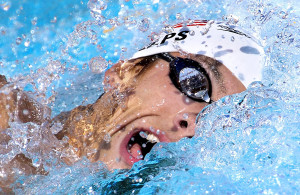 Image #7 Gold Getter, Michael Phelps … 2004 Summer Olympics, Athens, Greece. During my career coverage of 12 Olympic Games one athlete surfaces to the top as the greatest Olympian ever, Michael Phelps. This picture of Phelps captured during the 2004 Summer Olympic Games in Athens, Greece is my favorite action image of the most decorated Olympic athlete of all time. It comes as a result of careful study of each sport combined with patience looking for “the moment”, which is my cornerstone of success. It is the responsibility of the sports photographer to capture “the moment” which more often than not is the celebration of victory. Images of athletes pumping their fist, screaming in victorious manner with a display of unleashed emotion grace the covers of magazines and newspapers around the globe. I have those pictures to, but I seldom show them or receive much joy from them. For me, it is the image of an athlete performing, striving for excellence, and making their body do things that the rest of us can not do. That’s what attracts me to photographing sports. That is the kind of picture I like to make, and that is the reason why publications and companies have been hiring me since 1980 when my career began. Image #7 Gold Getter, Michael Phelps … 2004 Summer Olympics, Athens, Greece. During my career coverage of 12 Olympic Games one athlete surfaces to the top as the greatest Olympian ever, Michael Phelps. This picture of Phelps captured during the 2004 Summer Olympic Games in Athens, Greece is my favorite action image of the most decorated Olympic athlete of all time. It comes as a result of careful study of each sport combined with patience looking for “the moment”, which is my cornerstone of success. It is the responsibility of the sports photographer to capture “the moment” which more often than not is the celebration of victory. Images of athletes pumping their fist, screaming in victorious manner with a display of unleashed emotion grace the covers of magazines and newspapers around the globe. I have those pictures to, but I seldom show them or receive much joy from them. For me, it is the image of an athlete performing, striving for excellence, and making their body do things that the rest of us can not do. That’s what attracts me to photographing sports. That is the kind of picture I like to make, and that is the reason why publications and companies have been hiring me since 1980 when my career began.
I like it simple when it comes to sports coverage. I take the basic elements and photograph them in perfection. Michael Phelps is just that. The freestyle is the most basic and fundamental of all the swimming strokes. Almost all of us can do a few yards of freestyle, but no one in the world has done it better than Phelps.
Each day 200 of the worlds finest sports photographers would descend on the Olympic Aquatic venue in Athens to see if the record number of gold medals that USA Olympian Mark Spitz held would be surpassed. Each day they would arrive early, secure and guard their coveted photo position on the pool deck, and sit for several hours in 110 plus degree temperatures waiting for Phelps to swim. I too arrived early, but once I saw the mass of photographic humanity on the pool deck I was convinced that we would all get the same picture.
I have made a career photographing from locations different than my colleagues. This strategy produces a different picture. Not always better, but different. This location would allow me full view of the pool start to finish and a much better chance of seeing Michael’s face amongst the thrashing waters doing the Freestyle stroke. I had photographed Michael at previous competitions and knew where he would take his only mid-pool breath before pushing to the finish and hopefully, the gold. I positioned myself at a point a few meters behind his mid-pool “Breath Point” because I knew his entire face would be visible in the “trough” created during his Freestyle stroke. I used a Nikon 600mm with 1.4 Teleconverter so as to capture only his face as he took the single breath. Nikon D2h, ISO320, 1/2000 at f7.1, Nikon 600mm f4.0 lens with 1.4x Teleconverter, WB 5600K, Gitzo Carbon Fiber Monopod. |
 Hi and welcome to this edition of Workshop at the Ranch (WATR). At the time of this writing, the 2012 Summer Olympic Games in London, England are only a few hours away. With so many Golden Olympic Moments about to flood the NBC television air waves I thought it appropriate to recall some of my own favorite and personal Olympic memories in this month’s WATR article.
Hi and welcome to this edition of Workshop at the Ranch (WATR). At the time of this writing, the 2012 Summer Olympic Games in London, England are only a few hours away. With so many Golden Olympic Moments about to flood the NBC television air waves I thought it appropriate to recall some of my own favorite and personal Olympic memories in this month’s WATR article.







